Abstract
The modern global geopolitical transformations fueled by the armed conflict in Ukraine have greatly affected the countries of the European Union. Energy has become one of the biggest economic problems. The main objective of this study is to develop a methodology for assessing the level of electricity self-sufficiency in European Union member states. The author’s methodology is based on estimating the volume of exports and imports of electricity in relation to the amount of energy produced in individual EU countries. This approach makes it possible to determine the limits of effective electricity policy and distinguish the necessary changes and directions of action in the development of the energy sector at national and EU levels. The approval of the author’s methodology, carried out on the example of Croatia, made it possible to determine the current state of the country’s electricity system and the level of its security, and to distinguish the boundaries of the country’s effective electricity policy—the “triangle of effective policy”.
1. Introduction
The armed conflict in Ukraine (2022) became a decisive factor in the geopolitical transformation of the world, as it has accelerated the destruction of the economic order that had prevailed since 1945. The incident exacerbated the crisis phenomena that were already underway in various areas of the world’s socio-economic life; moreover, it accelerated technological progress and structural change, which became a test for the collective ability to respond to the crisis. At the same time, the sanctions against Russia have provided new challenges in the way of building a sustainable world, carrying out ecological and digital changes, and have even shifted the timeframe for the transition to renewable energy sources and changed the approach to energy security [1].
By 2022, the concept of energy security could be defined as “… the state of the economy, which ensures the meeting of current and future demand of consumers for fuels and energy, in a technically and economically reasonable manner, with minimal negative impact of the energy sector on the environment and living conditions of society” [2]. Now, when defining energy security, it is not enough to take into account the technical, economic, social, and environmental determinants, rather there must also be a determinant of geopolitical threat and a determinant of the self-sufficiency (autonomy) of the energy system of the country/community of countries. In the current geopolitical conditions, it is rather in terms of self-sufficiency that one can talk about energy security.
At the EU level, the so-called policy of “Strategic Autonomy” is being implemented today. Its main objective is to increase the overall level of security of the European Union, reduce dependence in critical areas, and increase the economic and political power of the community in regional and global dimensions [3,4]. Because the current situation in Ukraine is fueling energy problems, the issue of energy security has become extremely important [1]. That is, the implementation of the concept of sustainable development, based on caring for the environment [5] and technologies of the fourth industrial revolution [6,7,8,9,10], will only be feasible if a certain level of self-sufficiency in the energy system is achieved. Therefore, at the meeting of the European Council on 14 December 2022, the issues of the conflict in Ukraine, European security policy, and the development of defense capabilities, as well as the issues of digitization and economic and energy cooperation were discussed side by side [11]. On 3 February 2023, a summit was held between the European Union and Ukraine (the first summit since Ukraine was granted candidate status) [12], during which cooperation on the issues of rebuilding Ukraine were discussed, including cooperation in the energy field through interconnections in the electricity sector. This was an important step toward raising the level of energy security, not only for Ukraine, but also for the European Union. The inclusion of Ukraine’s electricity sector in the European system will increase the economic potential of the European Union, which, in turn, will raise the level of energy security and competitiveness of the EU economy and increase its influence in the global political arena.
In recent years, the issue of energy security has been at the center of attention of scientists around the globe. Scientific research on energy security problems includes climatic, social, economic, political, legal, and technological aspects, as follows:
- U.S. researchers have approached energy security from the side of climate and weather issues, linking them to economic and legal issues.
- (a)
- Shield S., Quiring S., Pino J., and Buckstaff K., analyzing the effects of Hurricane Harvey in Texas in 2017, proved that energy security in the United States is highly dependent on weather events. The results of their study showed that tropical cyclones, thunderstorms, and winter storms are responsible for 50% of all disruptions to US power grids, and power outages affect 83% of electric utility customers [13].
- (b)
- Busby J., Baker K., Bazilian M., Gilbert A., et al. analyzed the local power outages in Texas in February 2021 caused by Winter Storm Uri. To date, Texas’ self-sustaining electricity system, which is based primarily on the use of local wind turbines, has been considered one of the most efficient. However, Winter Storm Uri caused the electric grids to fail, and led to shaky operations in the manufacturing and service sectors, which are heavily dependent on electricity. This study concluded that the main problem was the interconnection of gas, electricity, and water systems, in such a way that the failure of one subsystem results in low efficiency or the failure of subsequent subsystems. The solution, the article proposed, is to integrate Texas’ state electricity system into the interstate grid. According to the authors, technical and political problems stand in the way of such grid interconnection [14].
- (c)
- Gupta R., Hamilton A., Reed P., and Characklis G. focusedon hydropower plants, given the uncertainty of snow melt dynamics in central Sierra Nevada. The authors referred to five multi-criteria evolutionary algorithms on the issue of financial risk, depending on weather events [15]. This was an approach to electricity security that combined economic and environmental factors.
- (d)
- In her study, Gundlach J. focused on the legal aspects of the power sector and its behavior in the face of ongoing climate change. The author highlighted the power sector’s failure to adapt to the changing climate and emphasized the reluctance of power companies to make such a transition. The very concept of electricity security was perceived by the author through the legal aspect of adapting the energy sector to ongoing climate change [16].
- Dutch researchers Rodhouse T., Pesch U., Cuppen E., and Correljé A. studied the problem of energy security from the social side and analyzed the points and level of inclusion of Dutch citizens in the energy system transformation process (namely, decarbonization of residential heating). According to the researchers, on the part of the authorities, the people were unfairly considered incompetent, incapable, and unwilling to implement new energy technologies and projects, which excluded the citizens from decision-making processes and slowed down the country’s energy transition. According to the authors, the solution to this problem lies in social integration on the basis of establishing appropriate roles, responsibilities, and mandates for the country’s citizens [17].
- A French–Filipino team of researchers distinguished the economic determinants of energy security. The research sample included 139 countries, and the indicators of energy security were analyzed for the years 1996–2016. The research conducted proved that the level of energy security depends on four main factors: the level of income, the quality of governance, the openness of the national economy to trade, and foreign direct investment [18]. Researchers from China and Pakistan take a similar view. They have suggested that, for the purposes of raising the level of electricity security on a sustainable basis for South Asian countries, it is necessary to expand the international energy trading system and increase so-called international investment in renewable energy [19].
- Axon C. and Darton R.—researchers from the UK—have pointed to the close relationship between energy security and sustainable development and have emphasized that growing geopolitical uncertainty and climate and environmental problems are worsening the situation in the energy security zone [20]. We can see a similar scientific approach referring to the close relationship between energy and geopolitics in the work of scientists from Italy [21], Norway, and The Netherlands [22], as well as Serbia and Slovenia [23].
- Rosewater D., Baldick R., and Santoso S. approached electric power security from the perspective of the efficiency of battery energy storage systems. In their article, the authors proposed a technological solution to electric power security, namely, a predictive model for energy storage control, which should minimize the risk of undesirable consequences and increase the level of efficiency of the power system [24]. From the side of reliability, robustness, and flexibility of energy systems, the issue of energy security has been addressed by Chinese scientist Zhou Y. [25].
In all of the scientific works reviewed, the concept of energy security is closely linked to the process of implementing the concept of sustainable development, including environmental protection. Such a point of view is also adhered to by scientists from China and Pakistan [26,27], Poland [28], Bangladesh, Singapore, Japan [29], and Ghana [30]. Australian researchers, using Vietnam as an example, have proven that the phase-out of coal power in the context of the energy transition also applies to developing countries [31].
It is worth noting that electricity deserves special attention in the area of energy security. This is due to the fact that the spread of fourth industrial revolution technologies is increasing the demand for electricity. The energy sector is becoming a strong bargaining chip against the backdrop of the unseen prospects for the resolution of the armed conflict in Ukraine and the geopolitical changes taking place. The issue of electric power security is one of the most important elements of the energy security of the European Union and the individual member countries as subjects, shaping the EU energy system [32,33].
Scientists have developed a number of methods and scientific approaches to assess the level of electricity security. These approaches take into account country specifics in pricing, regulation, environmental, and political aspects [34]; address cyber security questions [35]; and take into account the relationships between economic, environmental, and social indicators [28], uncertainties in economic policy, and government environmental spending [36]. However, there is a gap in the literature regarding the lack of methodological rigor in terms of the level of electricity self-sufficiency, which creates a gap between the normative and empirical debate, and becomes a barrier to raising the level of electricity security [9].
The main objective of this study is to develop a methodology for assessing the level of electricity self-sufficiency in European Union member states. The developed methodology will make it possible to distinguish the problems in the sphere of electric power security of individual European Union countries and to devise an appropriate strategy for the development of the energy sector at national and EU levels.
2. Materials and Methods
2.1. Preliminary Research: Ranking and Grouping of EU Countries by the Amount of Electricity Produced
The analysis of net electricity production statistics for the 27 European Union countries (excluding the UK) from 2016 to 2022 was carried out to rank and group EU countries in terms of the amount of electricity produced [37]. The calculations carried out showed that the cumulative electricity production of the EU-27 during the analyzed period amounted to 18,871.912 TWh. The minimum national share was 0.07%, or 12.578 TWh (Malta); the maximum national share was 19.89%, 3753.578 TWh (Germany); and the average monthly amount of electricity produced by the EU-27 was 224.665 TWh. The results of the preliminary analysis carried out indicated a high degree of diversity of national electricity systems in terms of the amount of electricity produced (Figure 1).
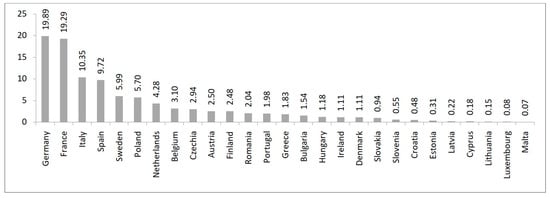
Figure 1.
Ranking of EU-27 countries according to their share of cumulative net electricity production between 2016 and 2022, %.
The calculations carried out show that 4 of the 27 countries of the European Union together generate more than half of the electricity generated in the territory of the European Union, i.e., 59.25%. These countries include Germany (the country’s share of cumulative electricity production was 19.89%), France (19.29%), Italy (10.35%), and Spain (9.72%). The leading countries are immediately followed by Sweden (5.99%), Poland (5.70%), and The Netherlands (4.28%). The cumulative share of the aforementioned 7countries in the EU-27 electricity production is 75.22%. Less than 25% of the EU’s electricity is produced by the remaining 20 member countries.
The calculations of the electricity balance of individual EU countries (Figure 2) show that there are countries with positive and negative electricity export/import balances (producer countries/consumer countries) in the European Union’s electricity system. Only eight EU member countries have a positive electricity balance—France, Germany, Sweden, the Czech Republic, Bulgaria, Slovenia, Romania, and Cyprus. The remaining 20 EU countries depend to varying degrees on electricity imports.
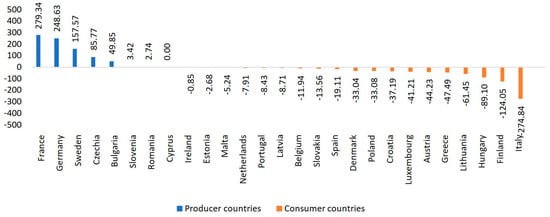
Figure 2.
Balance of electricity exports and imports, TWh.
For further research, we will distinguish groups of EU countries according to their share of cumulative electricity production. We will differentiate the groups of national power systems with the step of the share of electricity production—3.9646%, calculated using Formula (1), as follows:
where Step—step limiting shares of European Union countries in cumulative electricity production, %; Umax—the maximum value of the share of the national electricity system in the cumulative amount of electricity production, %; Umin—the minimum value of the share of the national electricity system in the cumulative amount of electricity production, %; and G—expected number of country groups.
The calculations based on Formula (1) made it possible to determine the criteria for grouping European Union countries according to their share of cumulative electricity production (Table 1).

Table 1.
Criteria for grouping EU countries according to their share in the cumulative electricity production of the EU-27 from 2016 to 2022.
The grouping of EU countries according to the established criteria (Figure 1, Table 1) is as follows: Group A—Germany (19.89%) and France (19.29%); Group B—no EU-27 country corresponds to the established limits of electricity production; Group C—Italy (10.35%) and Spain (9.72%); Group D—Sweden (5.99%), Poland (5.70%), and The Netherlands (4.28%); and Group E—all other EU countries (actual share 3.10% or less).
The descriptive statistics of the distinguished groups of countries, presented in Table 2, show that 25.93% of all member countries produced 75.22% of the electricity in the European electricity generation system between 2016 and 2022, further confirming the heterogeneity of the national cross-section of the EU electricity system.

Table 2.
Descriptive statistics of the distinguished groups of EU countries according to their share in the cumulative electricity production of the EU-27 from 2016 to 2022.
When summarizing the preliminary research, it can be concluded that there are structural disparities in the power system of the European Union—1/4 of all member countries produce ¾ of the electricity, resulting in the existence of countries of electricity producers and consumers. Taking into account that the overall level of electricity security of the European Union depends on the ability of the national electricity systems to meet their own needs, it is timely to develop a methodology for assessing the level of electricity security in individual member countries.
2.2. Methodology for Assessing the Level of Electricity Self-Sufficiency
The European Union’s energy security, among many other factors, depends on the level of electricity self-sufficiency. Increasing the electricity self-sufficiency of individual EU countries contributes to increasing the level of electricity security of the EU as a whole. “Self-sufficiency” in the given context is proposed to be defined as follows: “the possession of one’s own generating capacity and the ability to use it to generate electricity in the quantities necessary to meet one’s own electricity needs in a technically, economically and politically reasonable manner.”
The proposed methodology for assessing the level of electricity self-sufficiency consists of the following four basic steps:
- (1)
- Distinguishing classes of electricity self-sufficiency and assigning individual EU countries to the appropriate class.
- (2)
- Assessing the openness of individual national electricity systems and estimating the overall degree of international integration of the national electricity systems according to the amount of exports and imports of electricity compared to their own production.
- (3)
- Developing a matrix for estimating the level of electricity self-sufficiency and determining the limits of the effectiveness of the electricity policy of individual European Union member states.
- (4)
- Assessing the level of electricity self-sufficiency of individual EU countries.
1. In order to estimate the level of electricity self-sufficiency of national power systems, it is proposed to distinguish 12 classes of electricity self-sufficiency (Table 3). For this purpose, Formula (2) has been developed:
where Zij—the degree of electricity self-sufficiency of the i-th country in the j-m period, percentage points; Reij—the coefficient of exported electricity by i-th country in the j-m time period, %; Riij—the coefficient of imported electricity by the i-th country in the j-m time period, %; Iij—the amount of imported electricity by the i-th country’s power system in the j-m period, TWh; Eij—the amount of exported electricity by the i-th country’s power system in the j-m period, TWh; and Pij—the amount of net electricity produced by the i-th country’s power system in the j-m period, TWh.

Table 3.
The level and classes of electricity self-sufficiency of each country.
2. Since the level of electricity self-sufficiency of each country is strongly dependent on the amount of exports and imports of electricity, compared to its own production, we propose the development of classes of openness of each national electricity system and an estimation of the overall degree of international integration of the national electricity system according to the amount of exports and imports of electricity, compared to its own net production (Table 4).

Table 4.
Proposed classes of openness of the electricity system according to the amount of exported/imported electricity in relation to the level of its own net production.
We set the classes of openness of the national electric power system to exports and imports, respectively, according to the size of the exported electricity factor and the imported electricity factor. The overall degree of international integration of the national electric power system (Oij) is calculated using Formula (3), as follows:
The logic behind the assignment of the index to different classes and their interpretation is that the higher significance of a parameter corresponds to a higher degree of closure of the country’s electricity system for electricity exports or imports, respectively. For example, a national electricity system that has been assigned to the E6 class is more open to electricity exports than the national electricity system that has been assigned to the E8 class. This is similar for classes of system openness to electricity imports and classes of integration of the national electricity system.
3. In order to visualize the assessment of electricity self-sufficiency, and to determine the limits of the effectiveness of the electricity policy of individual EU member states and the EU-27, a matrix for estimating the level of electricity self-sufficiency has been developed.
The proposed basic matrix has dimensions of 100×100 (the matrix area can be enlarged as needed), as follows:
- The horizontal (x) axis of the matrix shows the amount of electricity exported in relation to the amount of electricity produced in the j-m time period (Reij);
- The vertical (y) axis of the matrix shows the amount of imported electricity in relation to the amount of electricity produced in the j-m time period (Riij);
- On the diagonal of the proposed matrix, there is a line representing the level of electricity sustainability. In other words, the comparison of the amount of exported electricity with the amount of imported electricity, expressed as a percentage of the amount of net electricity produced, is evaluated;
- The location of the analyzed national power system in relation to the line defining the level of electricity sustainability is proposed to be interpreted as follows:
- (a)
- The location of the analyzed national power system directly on the line of sustainability indicates a sustainable power system;
- (b)
- The distance between the point indicating the location of the i-th national electricity system on the metric space and the zero point is interpreted as the overall degree of integration into the international electricity space;
- (c)
- The location of the analyzed national power system above the equilibrium line indicates a power system with characteristics of dependence on external generation capacity;
- (d)
- The location of the analyzed national power system below the equilibrium line indicates an electricity system with the characteristics of a self-sufficient system that is not dependent on external electricity generation capacity.
To continue, it is necessary to determine the directions of effective transformation of the analyzed power system. For this purpose, it is necessary to find an answer to the following research question: “What incremental increase in produced electricity in the power system under study is necessary to achieve the level of electricity sustainability?”.
In the search for an answer to the above research question, several basic scenarios for the transformation of the electricity system under study must be developed. Once these scenarios are prepared, the “limits of effective electricity policy” must be distinguished.
An example of the construction of a matrix for estimating the level of electricity self-sufficiency of the 27 member countries of the European Union in 2016–2022 is given in Figure 3. The EU-27 point (13.91; 14.10) is the point where the European Union electricity system is located, where:
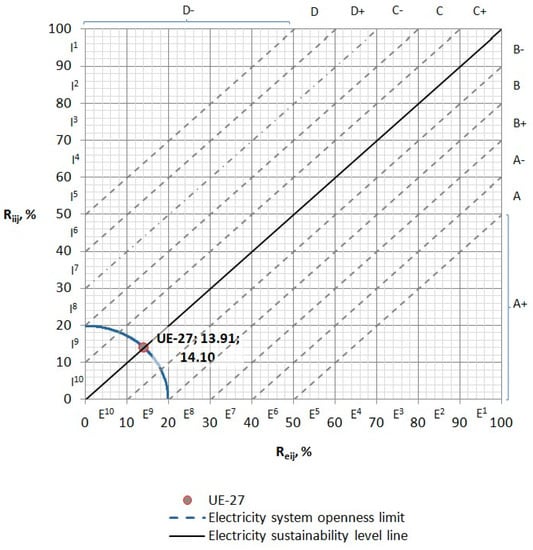
Figure 3.
Matrix for estimating the level of electricity self-sufficiency of the EU-27 from 2016 to 2022.
- A total of 13.91 is the reading for the X-axis (the percentage of the amount of electricity exported from the amount of its net production in the j-m period by the i-th system);
- A total of 14.10 is the reading for the Y-axis (the percentage of the amount of imported electricity from the amount of its production in the j-m period by the i-th system).
The evaluation of the electricity system and its belonging to one of the classes of electricity dependence is carried out on the basis of Table 3 and Table 4. Based on the results of the calculations carried out, we can place the European Union’s electricity system in class C+, namely, in a balanced system with elements of electricity scarcity (the Zij indicator for the EU-27 in 2016–2022 is −0.19). The European Union’s electricity system has a low level of openness to electricity exports and imports, as evidenced by its inclusion in classes E9 and I9 (ReUE = 13.91 and RiUE = 14.10). The level of overall openness of the power system, according to the proposed classification, corresponds to class O9 (OUE = 19.81), meaning that there is production capacity in the system to generate electricity in an amount that meets the demand. Such a system we can refer to as having a high level of self-sufficiency.
Figure 4, as an example, shows a matrix for estimating the level of electricity self-sufficiency for the EU countries with the largest share of cumulative electricity production of the EU-27 from 2016 to 2022. Of this group of countries, those closest to the line of the level of electricity sustainability are The Netherlands, Spain, and Poland, indicating a high level of electricity self-sufficiency for these countries.
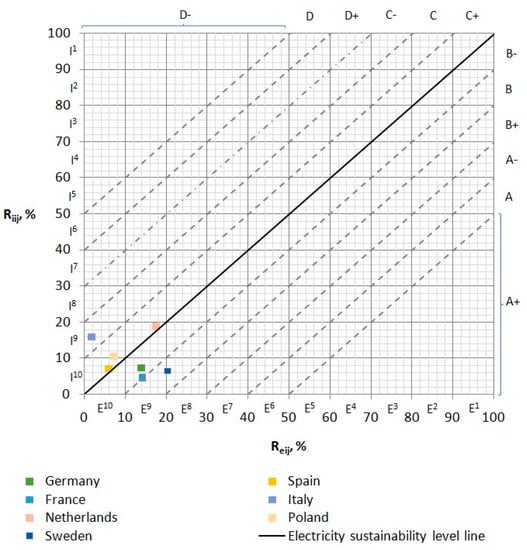
Figure 4.
Matrix for estimating the level of electricity self-sufficiency in selected EU-27 countries in 2016–2022.
4. The next step is to assess the self-sufficiency level of the power system under study.
Table 5 shows the criteria for assessing the level of electricity self-sufficiency. The formula for calculating the final assessment of the level of electricity self-sufficiency (Formula (4)) is as follows:
where K1…K5—self-sufficiency assessments according to the distinguished criteria.

Table 5.
Criteria for evaluating the electricity self-sufficiency of the system under study.
Such an assessment will make it possible to distinguish the problems in the sphere of electricity self-sufficiency of individual member states and the European Union as a whole and, on this basis, to work out an appropriate strategy for the development of the electricity sector at EU and national levels.
3. Approval of the Proposed Methodology for Assessing the Level of Electricity Self-Sufficiency Using the Example of Croatia
The approbation of the proposed methodology for assessing electricity self-sufficiency was carried out using the Croatian electricity system as an example (Figure 5). A point (Croatia-2016), with coordinates of 23.59 and 70.46, is marked on the metric space of the basic matrix, which represents the location of Croatia’s national electricity system in 2016.
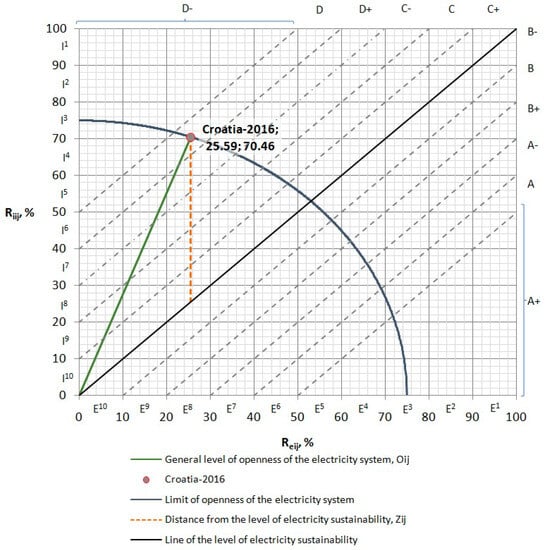
Figure 5.
Location of Croatia’s national electricity system on the matrix for estimating the level of electricity self-sufficiency in 2016.
Visually, we can see that the “Croatia-2016” point is above the line of the electricity sustainability level (the distance from the line of the Zij electricity sustainability level is −44.87 percentage points). According to the classification presented in Table 3, the Croatian electricity system can be characterized as an “import system” (class D), i.e., a system with a very low level of electricity self-sufficiency. The given system, from the point of view of assessing the openness to exports and imports, can be referred to class E8 and class I3. This means that there is a large disparity between the amount of electricity exports and imports, and that Croatia’s electricity system has a low level of self-sufficiency. That is, if it is disconnected from the generating capacity located outside of the country, the national power system will not be able to meet the domestic electricity demand. The above data have served as the reason for selecting the Croatian system in the quality of the object of the detailed analysis.
In order to determine the direction of effective transformation of the Croatian electric power system, we need to find an answer to the next research question: “What increment of produced electricity in the studied national power system is necessary to achieve the level of electricity sustainability?”.
In the search for an answer to the above research question, the following three scenarios for the transformation of the national electric power system were tested:
- Scenario I: The country’s demand for electricity grows; the electricity production increases; the additional electricity production is directed toward domestic consumption; and the exports and imports remain unchanged.
- Scenario II: The country’s demand for electricity is constant; the electricity production increases; the additional electricity production is directed to increase exports; and the imports remain unchanged.
- Scenario III: The country’s demand for electricity is constant; the electricity production increases; the additional electricity production is directed at reducing imports (replacing the imported electricity with the country’s own production); and the exports remain unchanged.
Under Scenario I, the volumes of the exports and imports (in TWh) remain unchanged, while the country’s own demand grows and is covered by additional generation capacity that has been installed in the country’s electricity system. Such assumptions will not allow the electricity system of Croatia to become completely self-sufficient (the export and import of electricity will remain unchanged, which means that, in the structure of the country’s electricity system, there will always be an observed surplus of imports over exports). On the other hand, this approach can contribute to minimizing the level of dependence on external generating capacity, and that is to increase the level of electricity self-sufficiency of the country. The simulation under Scenario I is shown in Figure 6.
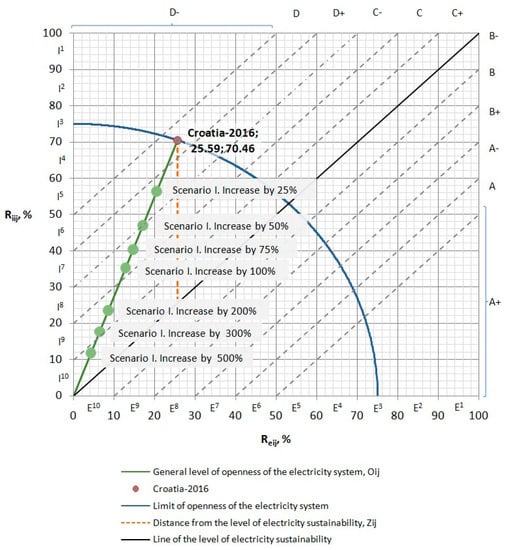
Figure 6.
Simulation of the implementation of Scenario I.
The simulation results show that, under the assumptions of the first scenario, the efficiency of the investment in Croatia’s power system will gradually decrease for each additional percentage of electricity generated (look at the line representing the overall level of openness of the power system in Figure 6). This also confirms the marginal utility of each additional unit of electricity generated if it is directed solely to meet the increasing needs (Figure 7). Thus, with a 200% or 300% increase in the amount of electricity generated by the Croatian system, the Zij index will be −14.96 and −11.22, respectively, which will place Croatia’s electricity system, according to the proposed classification (Table 3), at level C (currently D). This is a costly and low-impact direction for the transformation of the country’s electricity system, while, in the long run, it may favor lowering the country’s level of dependence on external power.
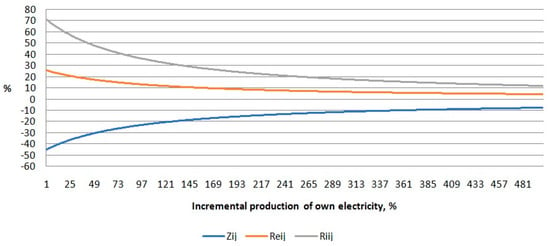
Figure 7.
Dynamics of change in the coefficient of exported electricity (Reij) and the coefficient of imported electricity (Riij) under the conditions of Scenario I.
4. Incremental Production of Own Electricity
Another, more effective solution is to direct the additional electricity generated to increase the electricity exports (Scenario II) or reduce the electricity imports (Scenario III), while setting electricity demand at a constant level. In this case, it is necessary to increase the amount of net electricity generated by the Croatian electricity system by 44.87% (the point of intersection of the zero level with the Zij line in Figure 8). All of the simulations have a slight degree of convexity (quasi linearity), which confirms the phenomenon of marginal utility.

Figure 8.
Dynamics of change in the coefficient of exported electricity (Reij) and the coefficient of imported electricity (Riij) under the conditions of the implementation of Scenario II and Scenario III.
The implementation of the second scenario, with a consistent increase in the amount of electricity being exported, will contribute to further opening Croatia’s national electricity system to external markets. On the one hand, this will result in an increased level of integration into the EU electricity system, and, on the other hand, the long-term implementation of such a scenario will contribute to internal capacity problems of the current facilities—the national electricity system will begin to act as a transit system.
The implementation of the third scenario, namely, the progressive replacement of imported electricity with its own production, will promote the reduction in the dependence of the national electricity system on the European Union system, which will reduce the burden on the EU system, reduce the level of losses associated with the transmission of electricity over longer distances, and, consequently, increase the efficiency of the operation and the level of electricity self-sufficiency of the EU-27.
The results of the simulations provide a basis for concluding that the most effective way to transform Croatia’s national electricity system, from the point of view of electricity self-sufficiency, is the implementation of Scenario III. Graphically, this looks like a shift on the metric space of the developed matrix of the point where the electricity system of Croatia is located in 2016, within the boundaries of the triangle, as follows: point 1—Croatia-2016 (25.59; 70.46), point 2—“Scenario II”, point 3—“Scenario III” (Figure 9).
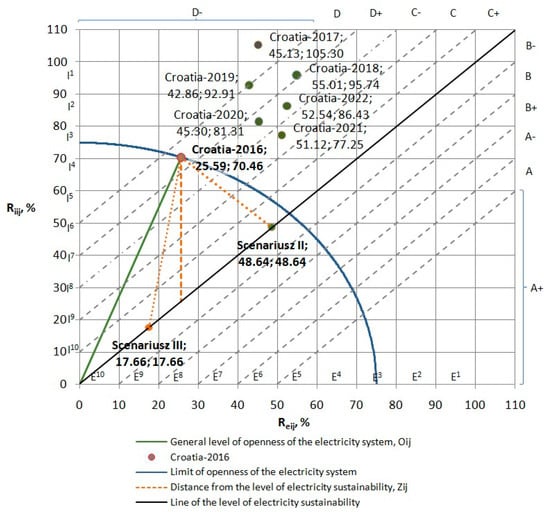
Figure 9.
Matrix for estimating the level of electricity self-sufficiency of Croatia in 2016–2022.
We can call this triangle the “triangle of effective national electricity policy”, and the positioning of the national electricity system within the boundaries of this triangle in the years to come will show an increase in the level of electricity self-sufficiency. The points where Croatia’s electricity system is in the analyzed years 2016–2022 are located above the equilibrium line and outside of the boundaries of the defined triangle, which indicates an electricity system that is dependent on external generation capacity and demonstrates the low effectiveness of the country’s electricity policy (i.e., a policy that has not resulted in raising the level of the country’s electricity self-sufficiency).
In order to assess the level of electricity self-sufficiency in Croatia for the period of 2016–2022, we will make an analysis according to the five criteria listed in Table 5. The results of the calculations presented in Table 6 confirm the previous suggestions about Croatia’s ineffective electricity policy in 2016–2022 (base year 2016). The worst situations were in 2017 and in 2019 (the final score for the five designated criteria is “−0.7” and the average score for the analyzed years is “−0.43”).

Table 6.
Assessment of Croatia’s electricity self-sufficiency level from 2016 to 2022 (base year 2016).
5. Conclusions
This study solves a complex scientific and practical problem related to raising the level of energy self-sufficiency in the European Union on the basis of the development of a methodology for assessing the level of the electricity self-sufficiency of EU member states. The author’s methodology is based on estimating the volume of exports and imports of electricity in relation to the amount of energy produced in individual EU countries. This approach makes it possible to determine the limits of effective electricity policy and distinguish the necessary changes and directions of action in the development of the energy sector at national and EU levels.
The main results of the conducted scientific research are as follows:
1. This study has shown that modern geopolitical transformations have greatly affected the countries of the European Union, forcing national and EU governments to correct their previous defense and economic policies. Energy has become one of the biggest economic problems, which has shifted the timeframe for the transition to renewable energy sources and has forced modifications on the way to the implementation of the concept of sustainable development.
2. The analysis of current scientific research in terms of energy security gives grounds to conclude that the concept of energy security is perceived from the level of caring for the environment in the implementation of the concept of sustainable development. At the same time, sustainable development needs the widespread implementation of fourth industrial revolution technologies, which causes an increase in the demand for electricity, and this means that the issue of electricity security is the most important element of the security of the national economy. With the energy sector becoming a bargaining chip of geopolitical transformations, as of today, the approach to electricity security should be based on the principles of self-sufficiency of individual economic units.
3. The study of contemporary European Union policy has shown that a strategy of autonomy is currently being pursued, aimed at raising the level of security and self-sufficiency of the entire EU economy, including the electricity system, and not necessarily the self-sufficiency of its individual members.
4. The analysis of statistical data has shown that the power system of the European Union is heterogeneous in terms of the amount of electricity produced by the individual member countries (in 2016–2022 in the EU-27, 26% of all of the member countries produced 75% of the electricity; moreover, in the power system of the European Union, there are countries with a positive and negative balance of exports/imports of electricity). This situation reduces the level of energy self-sufficiency of the European Union and needs the improvement of electricity policy at the level of the individual member countries.
5. In order to eliminate structural imbalances in the European Union’s electricity system, and to raise the overall level of energy self-sufficiency, this article has developed a methodology for assessing the level of electricity self-sufficiency of individual EU countries. The proposed methodology provides steps for the following: distinguishing the classes of electricity self-sufficiency of the EU countries; assessing the level of openness of the individual national electricity systems; and determining the limits of the effectiveness of the electricity policy of the individual EU countries and assessing the level of their electricity self-sufficiency.
6. The approval of the author’s methodology, carried out on the example of Croatia, made it possible to determine the current state of the country’s electricity system and the level of its self-sufficiency, and to distinguish the boundaries of the country’s effective electricity policy—the “triangle of effective policy”.
7. The assessment of the level of the country’s electricity self-sufficiency, carried out on the basis of the author’s methodology, can be used to identify the factors that cause the low level of electricity self-sufficiency of each country and develop an appropriate strategy for the development of the country’s electricity sector.
It is worth noting that the possibility of the practical transformation of national power systems is highly dependent on the energy policy pursued at the EU level. The hypothetical policy of the European Union may be directed at the concentration of the generating capacity of the energy-developed countries (such as Germany and France), which will result in raising the level of dependence of the smaller EU countries (such as Croatia) on electricity imports; or at the gradual increase in electricity production of individual EU countries in order to increase the amount of exported energy; or at building the EU electricity system on the principles of the optimization of generating capacity, with a view to creating strong (self-sufficient) national energy subsystems that are capable of replacing imported electricity with national production.
Author Contributions
Conceptualization, I.S. and A.S.; Methodology, I.S. and A.S.; Software, A.S.; Validation, A.S.; Resources, I.S.; Data curation, I.S. and A.S.; Writing—original draft, I.S. and A.S.; Visualization, A.S. All authors have read and agreed to the published version of the manuscript.
Funding
This research received no external funding. Some of the funds were partially covered by the affiliation institution. Part of the funds (EUR 780.39) covered by authors (Author Voucher discount code for completed reviews at the MDPI publishing house).
Data Availability Statement
All necessary data used for research purposes are available in open access on the website of the Central Statistical Office of the European Union. Available online: https://ec.europa.eu/eurostat/databrowser/product/page/NRG_CB_E__custom_5504793 (accessed on 22 June 2023).
Conflicts of Interest
The authors declare no conflict of interest.
References
- CIDOB. The World in 2023: Ten Issues That Will Shape the International Agenda. CIDOB Notes Internationals 283. Available online: https://www.cidob.org/en/publications/publication_series/notes_internacionals/283/the_world_in_2023_ten_issues_that_will_shape_the_international_agenda (accessed on 10 March 2023).
- Serwis Rzeczypospolitej Polskiej. Polski Atom. Bezpieczeństwo Energetyczne Podstawą Rozwoju Społeczeństwa. Available online: https://www.gov.pl/web/polski-atom/bezpieczenstwo-energetyczne-podstawa-rozwoju-spoleczenstwa (accessed on 11 March 2023).
- European Commission. Competence Centre on Foresight. Shift in the Geopolitical Landscape. November 2021. Available online: https://knowledge4policy.ec.europa.eu/foresight/shift-geopolitical-landscape_en (accessed on 10 April 2023).
- United Nations. Department of Economic and Social Affairs. Transforming our World: The 2030 Agenda for Sustainable Development. Available online: https://sdgs.un.org/2030agenda (accessed on 11 March 2023).
- EU-ASEAN Commemorative Summit. Joint Leaders’ Statement. Brussels, 14 December 2022. Available online: https://www.consilium.europa.eu/media/60846/eu-asean-leaders-statement.pdf (accessed on 10 April 2023).
- Broday, E.E. Participatory Ergonomics in the context of Industry 4.0: A literature review. Theor. Issues Ergon. Sci. 2021, 22, 237–250. [Google Scholar] [CrossRef]
- Calabrese, A.; Ghiron, N.L.; Tiburzi, L. Evolutions and revolutions in manufacturers implementation of industry 4.0: A literature review, a multiple case study, and a conceptual framework. Prod. Plan. Control. 2021, 32, 213–227. [Google Scholar] [CrossRef]
- Caruso, L. Digital innovation and the fourth industrial revolution: Epochal social changes? AI Soc. 2018, 33, 379–392. [Google Scholar] [CrossRef]
- Carvalho, N.; Chaima, O.; Cazarinia, E.; Gerolamo, M. Manufacturing in the fourth industrial revolution: A positive prospect in sustainable manufacturing. Procedia Manuf. 2018, 21, 671–678. [Google Scholar] [CrossRef]
- Schwab, K. The Fourth Industrial Revolution; Crown Business: New York, NY, USA, 2017; 192p. [Google Scholar]
- European Council. Council of the European Union. EU-ASEAN Commemorative Summit, 14 December 2022. Available online: https://www.consilium.europa.eu/en/meetings/international-summit/2022/12/14/ (accessed on 10 April 2023).
- European Council. Council of the European Union. EU-Ukraine Summit, 3 February 2023. Available online: https://www.consilium.europa.eu/pl/meetings/international-summit/2023/02/03/ (accessed on 10 April 2023).
- Shield, S.A.; Quiring, S.M.; Pino, J.V.; Buckstaff, K. Major impacts of weather events on the electrical power delivery system in the United States. Energy 2021, 218, 119434. [Google Scholar] [CrossRef]
- Busby, J.W.; Baker, K.; Bazilian, M.D.; Gilbert, A.Q.; Grubert, E.; Rai, V.; Rhodes, J.D.; Shidore, S.; Smith, C.A.; Webber, M.E. Cascading risks: Understanding the 2021 winter blackout in Texas. Energy Res. Soc. Sci. 2021, 77, 102106. [Google Scholar] [CrossRef]
- Gupta, R.S.; Hamilton, A.L.; Reed, P.M.; Characklis, G.W. Can modern multi-objective evolutionary algorithms discover high-dimensional financial risk portfolio tradeoffs for snow-dominated water-energy systems? Adv. Water Resour. 2020, 145, 103718. [Google Scholar] [CrossRef]
- Gundlach, J. Climate risks are becoming legal liabilities for the energy sector. Nat. Energy 2020, 5, 94–97. [Google Scholar] [CrossRef]
- Rodhouse, T.S.G.H.; Pesch, U.; Cuppen, E.H.W.J.; Correljé, A.F. Public agency and responsibility in energy governance: A Q study on diverse imagined publics in the Dutch heat transition. Energy Res. Soc. Sci. 2021, 77, 102046. [Google Scholar] [CrossRef]
- Le, T.-H.; Park, D. What drives energy insecurity across the world? A panel data analysis. Energy Res. Soc. Sci. 2021, 77, 102093. [Google Scholar] [CrossRef]
- Shah, S.A.A.; Zhou, P.; Walasai, G.D.; Mohsin, M. Energy security and environmental sustainability index of South Asian countries: A composite index approach. Ecol. Indic. 2019, 106, 105507. [Google Scholar] [CrossRef]
- Axon, C.J.; Darton, R.C. Sustainability and risk—A review of energy security. Sustain. Prod. Consum. 2021, 27, 1195–1204. [Google Scholar] [CrossRef]
- Cappelli, F.; Giovanni, C.; Pierluigi, V. Crude oil, international trade and political stability: Do network relations matter? Energy Policy 2023, 176, 113479. [Google Scholar] [CrossRef]
- Vakulchuk, R.; Overland, I.; Scholten, D. Renewable energy and geopolitics: A review. Renew. Sustain. Energy Rev. 2020, 122, 109547. [Google Scholar] [CrossRef]
- Šprajc, P.; Bjegović, M.; Vasić, B. Energy security in decision making and governance—Methodological analysis of energy trilemma index. Renew. Sustain. Energy Rev. 2019, 114, 109341. [Google Scholar] [CrossRef]
- Rosewater, D.; Baldick, R.; Santoso, S. Risk-Averse Model Predictive Control Design for Battery Energy Storage Systems. IEEE Trans. Smart Grid 2020, 11, 2014–2022. [Google Scholar] [CrossRef]
- Zhou, Y. Climate change adaptation with energy resilience in energy districts—A state-of-the-art review. Energy Build. 2023, 279, 112649. [Google Scholar] [CrossRef]
- Alemzero, D.A.; Sun, H.; Mohsin, M.; Iqbal, N.; Nadeem, M.; Vo, X.V. Assessing energy security in Africa based on multi-dimensional approach of principal composite analysis. Environ. Sci. Pollut. 2021, 28, 2158–2171. [Google Scholar] [CrossRef]
- Chen, J.; Huang, S.; Kamran, H.W. Empowering sustainability practices through energy transition for sustainable development goal 7: The role of energy patents and natural resources among European Union economies through advanced panel. Energy Policy 2023, 176, 113499. [Google Scholar] [CrossRef]
- Tutak, M.; Brodny, J. Analysis of the level of energy security in the three seas initiative countries. Appl. Energy 2022, 311, 118649. [Google Scholar] [CrossRef]
- Amin, S.B.; Chang, Y.; Khan, F.; Taghizadeh-Hesary, F. Energy security and sustainable energy policy in Bangladesh: From the lens of 4 As framework. Energy Policy 2022, 161, 112719. [Google Scholar] [CrossRef]
- Ofosu-Peasah, G.; Ofosu Antwi, E.; Blyth, W. Factors characterising energy security in West Africa: An integrative review of the literature. Renew. Sustain. Energy Rev. 2021, 148, 111259. [Google Scholar] [CrossRef]
- Do, T.N.; Burke, P.J. Phasing out coal power in a developing country context: Insights from Vietnam. Energy Policy 2023, 176, 113512. [Google Scholar] [CrossRef]
- Mišík, M. The EU needs to improve its external energy security. Energy Policy 2022, 165, 112930. [Google Scholar] [CrossRef]
- Boute, A. Weaponizing Energy: Energy, Trade, and Investment Law in the New Geopolitical Reality. Am. J. Int. Law 2022, 116, 740–751. [Google Scholar] [CrossRef]
- Tete, K.H.S.; Soro, Y.M.; Sidibé, S.S.; Jones, R.V. Assessing energy security within the electricity sector in the West African economic and monetary union: Inter-country performances and trends analysis with policy implications. Energy Policy 2023, 173, 113336. [Google Scholar] [CrossRef]
- CORDIS. European Commission. Shielding Europe’s Electrical and Power Systems. Available online: https://cordis.europa.eu/article/id/442942-shielding-europe-s-electrical-and-power-systems (accessed on 10 April 2023).
- Wang, K.-H.; Zhao, Y.-X.; Su, Y.H.; Lobonţ, O.-R. Energy security and CO2 emissions: New evidence from time-varying and quantile-varying aspects. Energy 2023, 273, 127164. [Google Scholar] [CrossRef]
- Eurostat. Net Electricity Generation by Type of Fuel—Monthly Data. Available online: https://ec.europa.eu/eurostat/databrowser/view/nrg_cb_pem/default/table?lang=en (accessed on 5 March 2023).
Disclaimer/Publisher’s Note: The statements, opinions and data contained in all publications are solely those of the individual author(s) and contributor(s) and not of MDPI and/or the editor(s). MDPI and/or the editor(s) disclaim responsibility for any injury to people or property resulting from any ideas, methods, instructions or products referred to in the content. |
© 2023 by the authors. Licensee MDPI, Basel, Switzerland. This article is an open access article distributed under the terms and conditions of the Creative Commons Attribution (CC BY) license (https://creativecommons.org/licenses/by/4.0/).